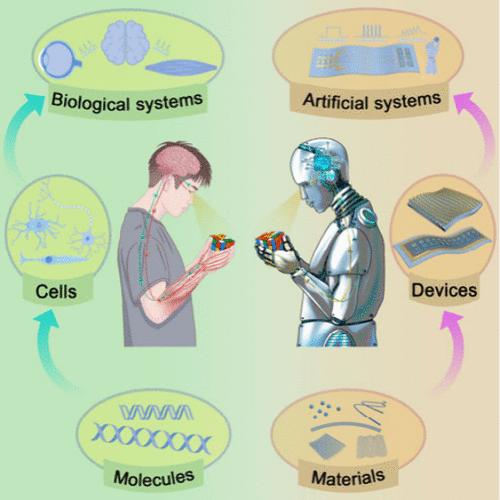当前位置:
X-MOL 学术
›
Chem. Rev.
›
论文详情
Our official English website, www.x-mol.net, welcomes your
feedback! (Note: you will need to create a separate account there.)
Nanomaterials for Flexible Neuromorphics
Chemical Reviews ( IF 51.4 ) Pub Date : 2024-11-05 , DOI: 10.1021/acs.chemrev.4c00369 Guanglong Ding, Hang Li, JiYu Zhao, Kui Zhou, Yongbiao Zhai, Ziyu Lv, Meng Zhang, Yan Yan, Su-Ting Han, Ye Zhou
Chemical Reviews ( IF 51.4 ) Pub Date : 2024-11-05 , DOI: 10.1021/acs.chemrev.4c00369 Guanglong Ding, Hang Li, JiYu Zhao, Kui Zhou, Yongbiao Zhai, Ziyu Lv, Meng Zhang, Yan Yan, Su-Ting Han, Ye Zhou

|
The quest to imbue machines with intelligence akin to that of humans, through the development of adaptable neuromorphic devices and the creation of artificial neural systems, has long stood as a pivotal goal in both scientific inquiry and industrial advancement. Recent advancements in flexible neuromorphic electronics primarily rely on nanomaterials and polymers owing to their inherent uniformity, superior mechanical and electrical capabilities, and versatile functionalities. However, this field is still in its nascent stage, necessitating continuous efforts in materials innovation and device/system design. Therefore, it is imperative to conduct an extensive and comprehensive analysis to summarize current progress. This review highlights the advancements and applications of flexible neuromorphics, involving inorganic nanomaterials (zero-/one-/two-dimensional, and heterostructure), carbon-based nanomaterials such as carbon nanotubes (CNTs) and graphene, and polymers. Additionally, a comprehensive comparison and summary of the structural compositions, design strategies, key performance, and significant applications of these devices are provided. Furthermore, the challenges and future directions pertaining to materials/devices/systems associated with flexible neuromorphics are also addressed. The aim of this review is to shed light on the rapidly growing field of flexible neuromorphics, attract experts from diverse disciplines (e.g., electronics, materials science, neurobiology), and foster further innovation for its accelerated development.
中文翻译:

用于柔性神经形态的纳米材料
通过开发适应性强的神经形态设备和创建人工神经系统,为机器注入类似于人类的智能,长期以来一直是科学探索和工业进步的关键目标。柔性神经形态电子学的最新进展主要依赖于纳米材料和聚合物,因为它们具有固有的均匀性、卓越的机械和电气能力以及多功能性。然而,该领域仍处于起步阶段,需要在材料创新和设备/系统设计方面不断努力。因此,必须进行广泛而全面的分析以总结当前的进展。本文重点介绍了柔性神经形态学的进展和应用,涉及无机纳米材料(零/一维/二维和异质结构)、碳基纳米材料(如碳纳米管 (CNT) 和石墨烯)以及聚合物。此外,还对这些器件的结构组成、设计策略、关键性能和重要应用进行了全面比较和总结。此外,还讨论了与柔性神经形态相关的材料/设备/系统的挑战和未来方向。本综述的目的是阐明快速发展的柔性神经形态学领域,吸引来自不同学科(例如电子学、材料科学、神经生物学)的专家,并促进进一步创新以加速其发展。
更新日期:2024-11-05
中文翻译:

用于柔性神经形态的纳米材料
通过开发适应性强的神经形态设备和创建人工神经系统,为机器注入类似于人类的智能,长期以来一直是科学探索和工业进步的关键目标。柔性神经形态电子学的最新进展主要依赖于纳米材料和聚合物,因为它们具有固有的均匀性、卓越的机械和电气能力以及多功能性。然而,该领域仍处于起步阶段,需要在材料创新和设备/系统设计方面不断努力。因此,必须进行广泛而全面的分析以总结当前的进展。本文重点介绍了柔性神经形态学的进展和应用,涉及无机纳米材料(零/一维/二维和异质结构)、碳基纳米材料(如碳纳米管 (CNT) 和石墨烯)以及聚合物。此外,还对这些器件的结构组成、设计策略、关键性能和重要应用进行了全面比较和总结。此外,还讨论了与柔性神经形态相关的材料/设备/系统的挑战和未来方向。本综述的目的是阐明快速发展的柔性神经形态学领域,吸引来自不同学科(例如电子学、材料科学、神经生物学)的专家,并促进进一步创新以加速其发展。






























 京公网安备 11010802027423号
京公网安备 11010802027423号